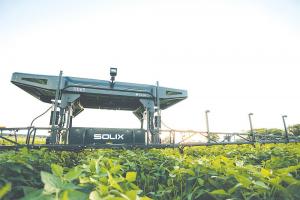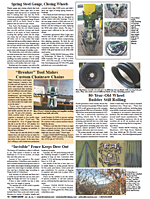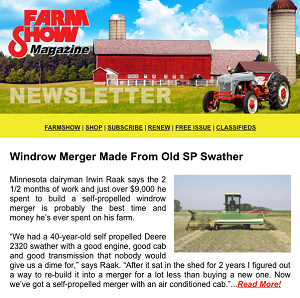Weed Robots Save On Labor And Chemicals
 ✖  |
Set up a Solix robot in a field and let it go, spraying target weeds as needed until the crop canopies. No refueling, no driver needed. Just refill the tanks and check your cell phone for alerts should a problem develop. Not only are weeds controlled, but the solar-powered sprayer is scouting the field, collecting valuable field data as it goes.
“We had 50 robots running in the field this year, our second crop year in Indiana and Illinois,” says Taylor Wetli, Solinftec. “Next year, we’ll be north of 100 units working from Indiana to Kansas. We’re also starting our second commercial season in Brazil.”
The 1,200-lb. Solix robot looks a bit like a high table on wheels with a 40-ft. boom. The chassis is 7 ft. by 7 ft. at the base. The four-panel tabletop solar array extends slightly over the chassis to capture available solar power, including UV rays.
“Even in the case of clouds or smoke-induced haze, the arrays capture enough UV rays to allow it to run and store energy,” says Wetli.
The chassis holds batteries and the AI control system. Electric wheel motors on two table legs pull the machine through the field.
Cameras every 5 ft. on the boom feed images to the AI. As the robot passes overhead at about 5 in. per sec., a 12-in. by 12-in. spray pattern is laid over the target weed.
In one case study of a 135-acre field, Solix identified 737,726 weeds. It sprayed 150.2 gal. of solution in square-foot blocks on a total of 8.1 acres, reducing chemical inputs by 94 percent over conventional broadcast spraying.
“Solix can identify seedlings as small as 1/2 in. high with our heightened sensitivity. However, our standard identification is 2 in. or larger,” says Wetli.
Targeted applications using AI for independent nozzle control require less spray solution, which reduces weight and potential soil compaction. The Solix is equipped with two 20-gal. tanks. The solution is recirculated in the tanks every 6 hrs. to keep the product mixed. The dual tanks self-level as the solution is applied.
Inch by inch, foot by foot, the robot covers the field, 5 acres per hr., averaging 50 acres per day. “Currently, we’re not applying at night due to label restrictions and product efficacy for the products we’re applying,” says Wetli. “However, we do have the capability to scout at night.”
On average, each machine makes four application passes in soybeans and three in corn. Additional passes are made to scout the field, monitor and understand field conditions, and gather data. This includes the identified weeds, plant population and placement, crop health and more.
When to apply is based on a combination of grower/agronomist recommendations and Solix-generated weed maps showing the percentage of a field with weeds.
Solix units are designed to operate independently. They’re monitored and managed by software or the growers using an app or webpage. The machine navigates the field using maps updated by the grower to mark out different areas, such as standpipes, waterways and spray/no-spray zones.
Wetli notes that precision spraying of individual weeds versus broadcast spraying reduces input costs. It also reduces or eliminates the need for the crop to metabolize the product, which can increase yield.
Solinftec estimates a three-year return on investment for 300 acres. The more acres covered, the faster the return.
“Some customers keep their machines in a single field for multiple passes, while others move them from one field to another, such as from corn to a double crop field,” says Wetli. “In the latter case, a machine might cover 600 acres.”
Refilling the onboard tanks is the only human interaction needed for the Solix to function. However, that, too, will be automated in the future.
“We’ll have automatic refill stations in place on a limited scale next year,” says Wetli. “The unit will simply back up to the station, connect and refill. With refill stations, there’s the potential to have multiple products available. If the machine recognizes a need for an alternative product, it could grab it on refill.”
Currently, only one size unit is offered, but this may change in the future. He notes that growers are enthused about the machine’s current capabilities and can justify the machine in terms of savings on chemical inputs and increases in yield. As more data layers are gathered, Wetli is confident that more yield increases will be seen.
“They’re excited about what they can do with the data gathered,” he says. “The platform will continue to evolve. Growers may use it to apply microbials or fungicides earlier or at multiple times. We’ve seen it work with weed control. Now we’ll see what more it can do.”
Contact: FARM SHOW Followup, Solinftec, 3323 Concord Rd., Suite 2 e 3, Lafayette, Ind. 47909 (ph 765-269-4733; change.ag@solinftec.com; www.solix.solinftec.com).

Click here to download page story appeared in.
Click here to read entire issue
Weed Robots Save On Labor And Chemicals SPRAYING New Sprayers Set up a Solix robot in a field and let it go spraying target weeds as needed until the crop canopies No refueling no driver needed Just refill the tanks and check your cell phone for alerts should a problem develop Not only are weeds controlled but the solar-powered sprayer is scouting the field collecting valuable field data as it goes “We had 50 robots running in the field this year our second crop year in Indiana and Illinois ” says Taylor Wetli Solinftec “Next year we’ll be north of 100 units working from Indiana to Kansas We’re also starting our second commercial season in Brazil ” The 1 200-lb Solix robot looks a bit like a high table on wheels with a 40-ft boom The chassis is 7 ft by 7 ft at the base The four-panel tabletop solar array extends slightly over the chassis to capture available solar power including UV rays “Even in the case of clouds or smoke-induced haze the arrays capture enough UV rays to allow it to run and store energy ” says Wetli The chassis holds batteries and the AI control system Electric wheel motors on two table legs pull the machine through the field Cameras every 5 ft on the boom feed images to the AI As the robot passes overhead at about 5 in per sec a 12-in by 12-in spray pattern is laid over the target weed In one case study of a 135-acre field Solix identified 737 726 weeds It sprayed 150 2 gal of solution in square-foot blocks on a total of 8 1 acres reducing chemical inputs by 94 percent over conventional broadcast spraying “Solix can identify seedlings as small as 1/2 in high with our heightened sensitivity However our standard identification is 2 in or larger ” says Wetli Targeted applications using AI for independent nozzle control require less spray solution which reduces weight and potential soil compaction The Solix is equipped with two 20-gal tanks The solution is recirculated in the tanks every 6 hrs to keep the product mixed The dual tanks self-level as the solution is applied Inch by inch foot by foot the robot covers the field 5 acres per hr averaging 50 acres per day “Currently we’re not applying at night due to label restrictions and product efficacy for the products we’re applying ” says Wetli “However we do have the capability to scout at night ” On average each machine makes four application passes in soybeans and three in corn Additional passes are made to scout the field monitor and understand field conditions and gather data This includes the identified weeds plant population and placement crop health and more When to apply is based on a combination of grower/agronomist recommendations and Solix-generated weed maps showing the percentage of a field with weeds Solix units are designed to operate independently They’re monitored and managed by software or the growers using an app or webpage The machine navigates the field using maps updated by the grower to mark out different areas such as standpipes waterways and spray/no-spray zones Wetli notes that precision spraying of individual weeds versus broadcast spraying reduces input costs It also reduces or eliminates the need for the crop to metabolize the product which can increase yield Solinftec estimates a three-year return on investment for 300 acres The more acres covered the faster the return “Some customers keep their machines in a single field for multiple passes while others move them from one field to another such as from corn to a double crop field ” says Wetli “In the latter case a machine might cover 600 acres ” Refilling the onboard tanks is the only human interaction needed for the Solix to function However that too will be automated in the future “We’ll have automatic refill stations in place on a limited scale next year ” says Wetli “The unit will simply back up to the station connect and refill With refill stations there’s the potential to have multiple products available If the machine recognizes a need for an alternative product it could grab it on refill ” Currently only one size unit is offered but this may change in the future He notes that growers are enthused about the machine’s current capabilities and can justify the machine in terms of savings on chemical inputs and increases in yield As more data layers are gathered Wetli is confident that more yield increases will be seen “They’re excited about what they can do with the data gathered ” he says “The platform will continue to evolve Growers may use it to apply microbials or fungicides earlier or at multiple times We’ve seen it work with weed control Now we’ll see what more it can do ” Contact: FARM SHOW Followup Solinftec 3323 Concord Rd Suite 2 e 3 Lafayette Ind 47909 ph 765-269-4733; change ag@solinftec com; www solix solinftec com
To read the rest of this story, download this issue below or click
here to register with your account number.







